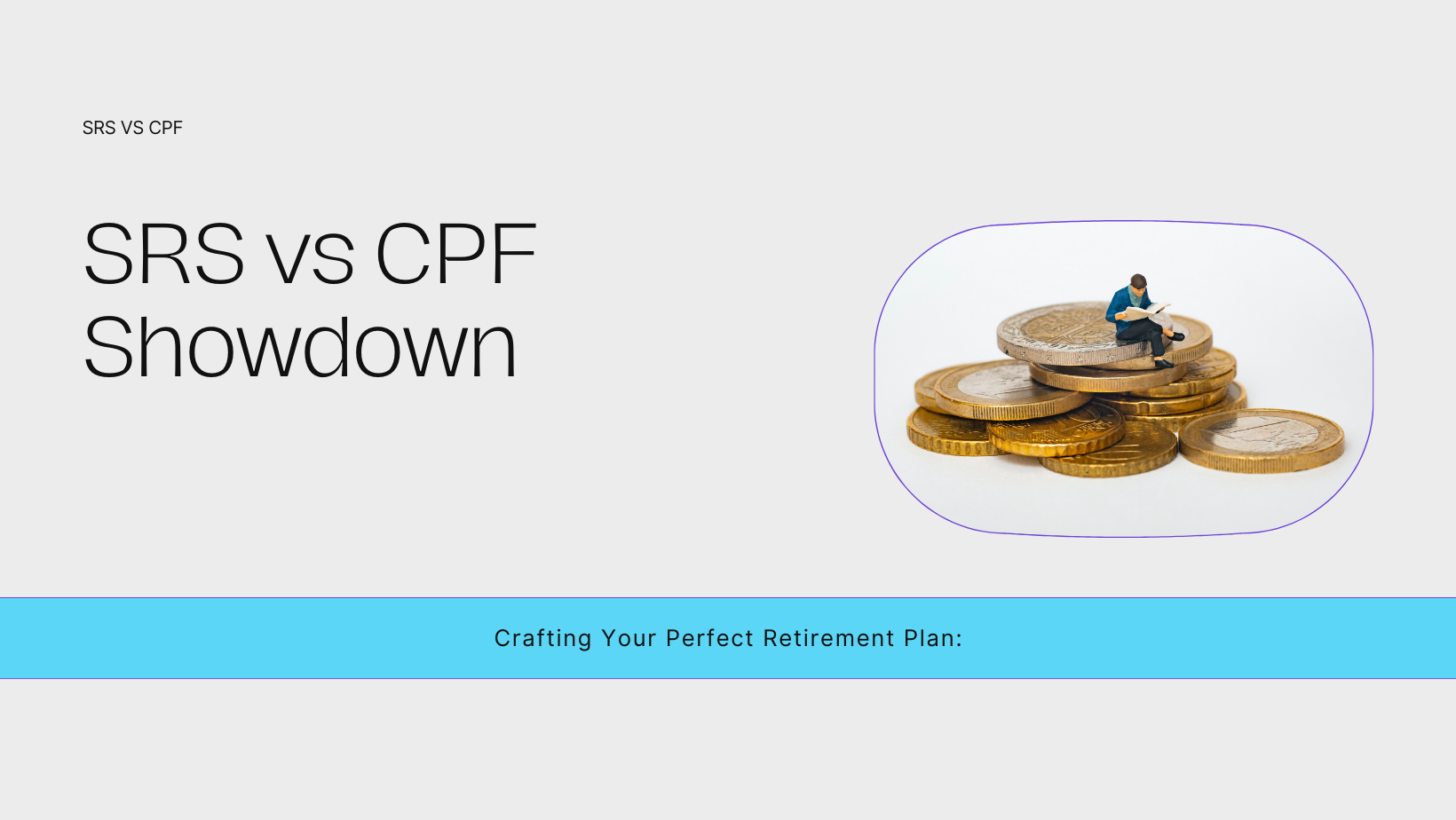SRS vs CPF: Retirement Comparison
When it comes to planning for retirement in Singapore, two key acronyms come to mind: SRS vs CPF. These are like the Batman and Superman of Singapore’s retirement landscape, each with its own unique superpowers. But which one is the true hero for your golden years? Join me as we dive into the world of SRS and CPF, with a dash of wit and a sprinkle of financial wisdom, to find out which is your best bet for retirement.
SRS vs CPF: Tax Benefits Unveiled
In the left corner, we have the Supplementary Retirement Scheme (SRS). SRS offers a fantastic tax advantage,open to both Singaporeans and foreigners. When you contribute to your SRS account, you get to enjoy tax relief. It’s like getting a bonus from the taxman for saving for your future. However, remember that you’ll be taxed when you withdraw from your SRS account during retirement. So, it’s a bit of a give-and-take in the battle of SRS vs CPF.
And in the right corner, we have the Central Provident Fund (CPF), our friendly neighbourhood retirement fund. CPF provides a different kind of tax benefit. You get to enjoy tax relief when you contribute to your Ordinary and Special Accounts. Plus, the interest earned on your CPF savings is tax-free. It’s like a tax-free buffet for your retirement fund. But, here’s the catch: there’s a cap on how much you can save in your CPF.
Tax Benefits
| Aspect |
SRS |
CPF |
| Tax Benefit |
Tax relief when you contribute. Taxed upon withdrawal. |
Tax relief when you contribute. Tax-free interest. |
Real-Life Example: Consider Jane, who contributes $15,000 to her SRS account. She can enjoy tax relief on that amount. However, when she withdraws from her SRS account during retirement, she’ll be taxed based on her income tax rate at that time.
On the other hand, let’s take John, who contributes the same amount to his CPF accounts. He also enjoys tax relief when contributing, and the interest he earns on his CPF savings is entirely tax-free. However, there’s a cap on how much he can save in CPF.
SRS vs CPF: Navigating Access to Funds
SRS has a slight upper hand in terms of flexibility in the SRS vs CPF comparison. You can start withdrawing your SRS funds anytime from your statutory retirement age (currently 62), and you have up to 10 years to make withdrawals. This flexibility allows you to plan your withdrawals according to your financial needs and tax situation.
CPF, on the other hand, has specific withdrawal policies based on the various accounts within it. The retirement account (RA) can start providing a monthly payout from the age of 65. The Ordinary and Special Accounts have different withdrawal rules, and there are limitations to the amount you can withdraw.
Access to Funds
| Aspect |
SRS |
CPF |
| Withdrawal Flexibility |
Can withdraw anytime after statutory retirement age with a 10-year window. |
Specific withdrawal rules based on accounts. |
Real-Life Example: Let’s look at Mary, who chooses to use her SRS funds. She’s 62 years old, and she decides to start withdrawing a portion of her SRS savings for the next five years to supplement her retirement income. The flexibility of SRS allows her to plan her withdrawals strategically.
Conversely, David, who relies on CPF, can only start receiving monthly payouts from his CPF Retirement Account at the age of 65. This means less flexibility in managing his retirement income.
SRS vs CPF: Investment Options Demystified
SRS offers a broader range of investment options. You can invest your SRS funds in various financial instruments, including stocks, bonds, SRS endowment plans, and unit trusts. This diversity allows you to potentially earn higher returns if you’re willing to take on some risk.
CPF, while safe and reliable, has more limited investment options. The Special Account (SA) and the Medisave Account (MA) mainly earn a fixed interest rate. The Ordinary Account (OA) has some investment options, but they are less versatile than SRS. Investing your SA savings, on the other hand, requires setting aside a higher minimum amount than the OA.
Investment Options
| Aspect |
SRS |
CPF |
| Investment Variety |
Diverse investment options (stocks, bonds, unit trusts). |
Limited investment options. |
Real-Life Example: Imagine Sarah, who decides to invest a portion of her SRS savings in a mix of stocks and bonds. Over the years, her investments yield an average annual return of 7%. This higher potential return boosts her retirement fund significantly.
On the other hand, Tom, who relies on his CPF, earns a fixed interest rate of around 4.04% on his Special Account. While it’s a safe option, the returns may not match what Sarah could achieve with her SRS investments.
SRS vs CPF: The Role of Employers in Your Retirement
Here’s a twist: your employer can contribute to your CPF but not to your SRS. Your CPF contributions include a portion from your employer, which can significantly boost your retirement savings over time.
The Role of Employers in Your Retirement
| Aspect |
SRS |
CPF |
| Employer Contributions |
No employer contributions. |
Employer contributions boost savings. |
Real-Life Example: Let’s consider Alex and Rachel. Alex contributes to his CPF, and his employer matches his contributions. This means that he gets an additional financial boost to his retirement savings, courtesy of his employer.
In contrast, Rachel opts for SRS. While she enjoys the tax benefits and flexibility, there are no additional contributions from her employer. She’ll need to rely solely on her contributions and the returns from her SRS investments.
SRS vs CPF: Crafting the Perfect Retirement Strategy

So, which is the winner? It really depends on your individual financial goals and circumstances. SRS wins when it comes to tax benefits, flexibility, and investment options. However, CPF’s employer contributions give it a significant advantage. In many cases, it’s a good strategy to use both SRS and CPF together in your retirement planning.
SRS vs CPF: The Grand Comparison
| Aspect |
Supplementary Retirement Scheme (SRS) |
Central Provident Fund (CPF) |
| Tax Benefits |
Tax relief when you contribute. Taxed upon withdrawal. |
Tax relief when you contribute. Tax-free interest. |
| Access to Funds |
Can withdraw anytime after statutory retirement age with a 10-year window. |
Specific withdrawal rules based on accounts. |
| Investment Options |
Diverse investment options (stocks, bonds, unit trusts). |
Limited investment options. |
| Employer Contributions |
No employer contributions. |
Employer contributions boost savings. |
This grand comparison table summarizes the key differences between SRS and CPF, making
Remember, it’s not about choosing one over the other; it’s about making them work together in harmony. Use the tax benefits of SRS wisely while capitalizing on the employer contributions and safety net of CPF.
In the ultimate showdown of SRS vs CPF, there’s no clear-cut winner. The best bet for your retirement is a combination of both, just like how Batman and Superman team up to save the day. So, take the time to understand the unique strengths of SRS and CPF and make them your dynamic retirement duo. Your financial future will thank you for it.
Got more questions or need personalized advice? Reach out to us for a customized solution tailored to your needs. Your retirement journey is about to get a whole lot more exciting!




1 Comment